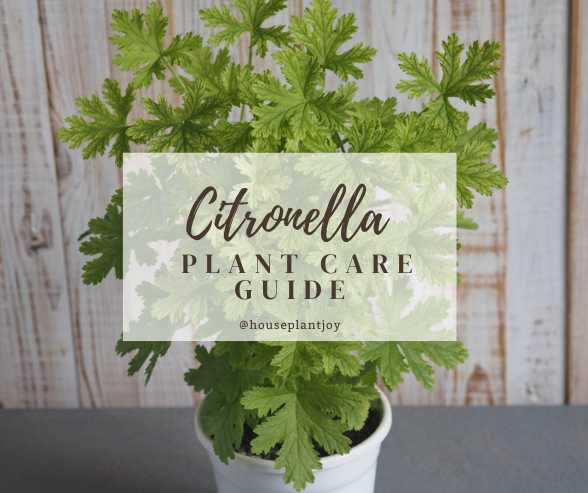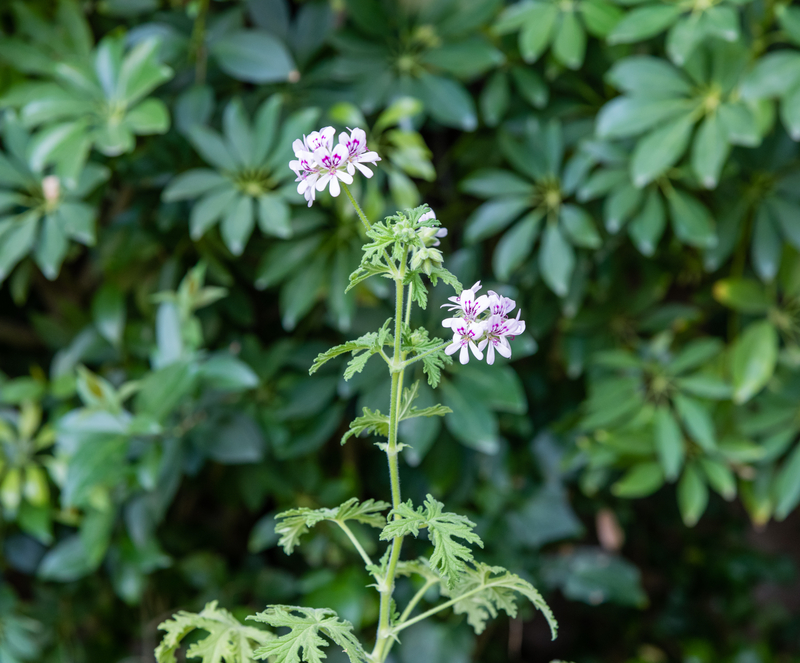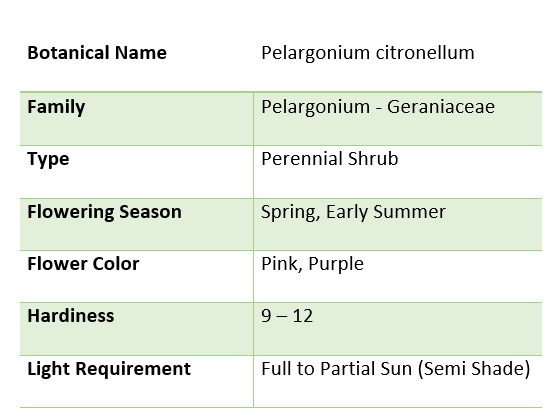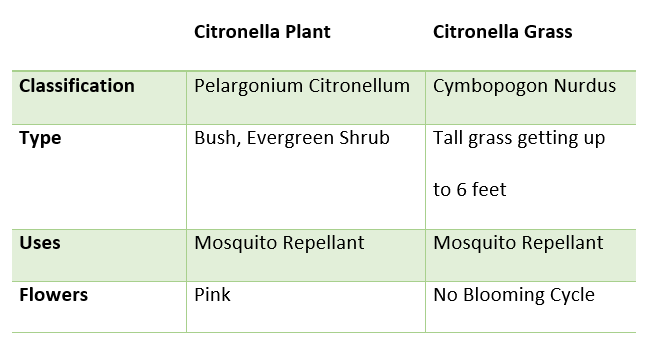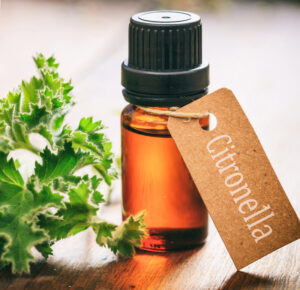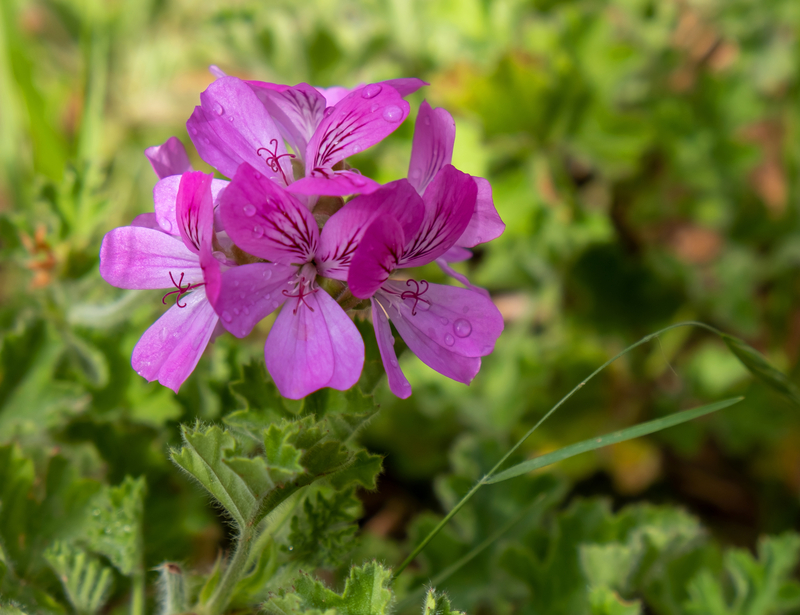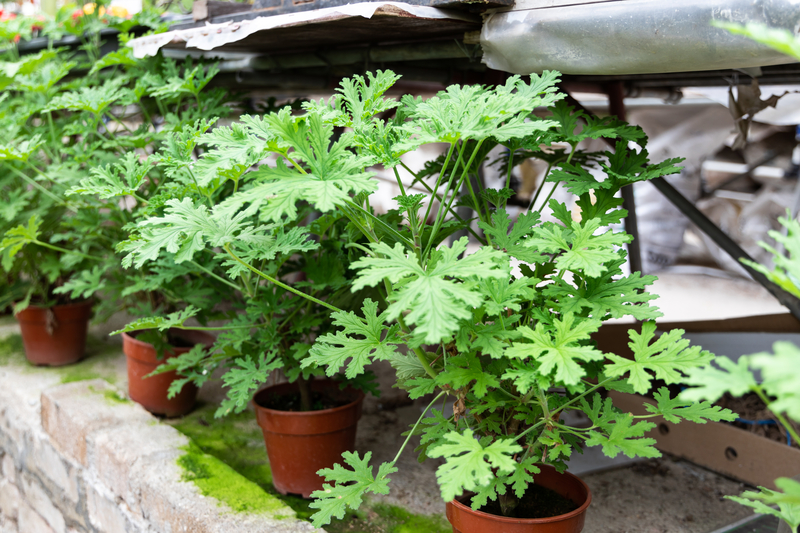HousePlantJoy is supported by our audience. When you purchase through one of our links, we may earn a small affiliate commission. As an Amazon Associate I earn from qualifying purchases. Your cost is not affected.
==================
If you’re looking for a natural way to keep mosquitoes at bay, look no further than citronella candles and oil burners. They are only possible because people made them from the parts of plants. Read to learn more about citronella plant care, its benefits, and how it infuses a pleasant citrus aroma as a houseplant!
The citronella plant (Pelargonium citronella) is incredibly prized for its citrus-like fragrance. Some gardeners use Citronella plants to get rid of mosquitos. After all, they are some of the most annoying bugs and can cause serious illnesses. They use them as a natural mosquito repellent rather than reaching for bug zappers or chemical sprays.
Citronella Plant Care
Many people grow Citronellas as houseplants around their patios, porches, and gardens. Some people use the citronella plant as a mosquito repellant by processing them. They crush its leaves to extract oil from them and then apply it to their skin. But it doesn’t mean that the oil will end mosquitos. It is only beneficial for protecting yourself from mosquitos for a while
These plants, commonly known as the mosquito plant citronella, don’t necessarily eliminate or repel buzzing insects entirely. However, cultivating a citronella field is a simple and aesthetically pleasing endeavor. Moreover, the mere presence of these plants contributes to keeping mosquitoes at bay from your property.
Regardless of the citronella plant benefits, some people may not like them. Several individuals find citronella essential oil irritating and are allergic to it. So it is highly advised to seek your doctor’s advice before applying it.
So, how to grow the citronella plant, and what are its benefits? This detailed guide will equip you with valuable citronella plant care tips. So, let’s get started!
Citronella Plant Description
Citronella Plant Care
Before we discuss Citronella indoor plant care, we need to know more about the citronella plant. Also commonly referred to as the mosquito plant, it is among the perennial aromatic species. Also, it’s a member of the Geraniaceae family. Originating from tropical Asia, these plants are a significant source of essential citronella oil.
Moreover, the plant is a cross between rose-aromatic geraniums and citronella grass. Because of that, it produces a strong, lemony fragrance. They are tall, fast-growing plants with lacy green leaves and pink, lavender blooms. Citronella plant as mosquito repellant has a strong scent, making it a beautiful addition to flower arrangements.
Citronella Plant vs. Citronella Grass
Many newbie gardeners think of citronella plants and citronella grass as one plant species. But they are very different from each other. The citronella plant is a flowering evergreen shrub. Still, citronella grass is ornamental and lacks a flowering cycle.
Moreover, these plants also have different origins. Citronella plants are abundant in South Africa, whereas citronella grass originates in South Asia. Yet, one common characteristic between these two is their fragrance, which produces a pleasant lemony scent.
Citronella Plant Benefits
So, why should you grow and learn about citronella plant care? Here are a few citronella plant benefits which make it an excellent addition to your garden.
citronella Plant benefits
- People appreciate the citronella plant, a mosquito repellant, for its strong scent. It is a natural solution to keep mosquitos at bay and has no side effects like chemical sprays or bug zappers. You can place it around your living area to infuse a pleasant fragrance. Other than mosquitos, citronella plants repel other irritating flies and insects.
- The citronella plant’s strong scent doesn’t hurt pollinators like bees or spiders. Similarly, butterflies and hummingbirds don’t mind this plant as well. The plant repels only the pesky biting and stinging insects we hate the most.
- Citronella plant care also means you can dry and use its leaves as a potpourri.
- The plant adds texture and scent to floral arrangements and repels mosquitoes.
- Scented pelargonium species also treat respiratory, renal, intestinal, fever, wounds, and other ailments.
- These plants, when grown in pots, create a more welcoming environment. Its texture-rich leaves and summer blossoms are a sight for sore eyes.
These enticing citronella plant benefits are hard to overlook. So, if you plan to grow them, here’s a citronella plant care guide.
How to Grow Citronella Plant?
Growing citronella plants as mosquito repellant is a straightforward process. These plants are accessible, fast-growing, and don’t need much attention. Citronellas are great indoor and outdoor plants that naturally repel mosquitoes. Also, they can be grown outside all summer in USDA zones 9–11 because they are hardy all year. But, ensure to move it indoors before the first frost.
Citronella Plant as Mosquito Repellant
When choosing a citronella plant, buy one with healthy, deep green leaves. Then gently pull it out of its container and analyze the roots. Healthy plants should have bright white roots rather than tightly matted roots.
Moreover, these plants grow well in full to partial sun. But regions with extreme heat mean your citronella plant will appreciate some afternoon shade. For instance, if you have your plant on your patio, find a place where it can get plenty of morning sun and some afternoon shade.
In the same way, you can grow these plants along a walkway, where their leaves will likely brush against each other and release a calming scent.
Citronella Plant Care
As mentioned, outdoor and indoor growing is one of the citronella plant benefits. But, they will be happiest outdoors. On top of that, they can thrive outdoors year-round in USDA zones 9 – 11. Here are a few citronella plant care tips:
-
Citronella Plant Light Requirements
Citronella plant, as a mosquito repellant, prefers tons of light. Exposing your plant to full sun promotes healthy growth and prevents becoming leggy. Also, the more sun exposure, the better the blooms. So, while citronella can bear a lot of sunlight, providing them with bright, filtered light is also beneficial. That said, you can place your citronella plant on the west-facing window or under a tree so it can get some afternoon shade.
-
Soil for Citronella Plant
-
Citronella Plant Watering
Even if you are growing citronella plants outdoors, don’t wait for rainfall to satisfy your watering needs. While easy care is one of the citronella plant benefits, you should check the soil regularly. If you feel the top 2 inches of the soil dry, it’s time to water your plant thoroughly.
Also, you should know that if you forget to water your citronella plant for too long, the leaves will turn yellow and fall off.
-
Citronella Plant Temperature and Humidity
-
Citronella Plant Fertilization
Like many other plant species that benefit from fertilization, the citronella plant isn’t an exception. If you want your plant to grow healthy and produce denser blooms, provide it with a well-balanced fertilizer in the summer. Yet, they are not heavy feeders; fertilizing once a month during their active growth in spring and summer should be enough. Also, avoid fertilizing them in the fall and let your plant rest.
Citronella plant care is easy. If you’re tired of using chemical sprays to repel mosquitos, try growing the citronella plant as a mosquito repellant. One of the citronella plants benefits is letting you enjoy your summer nights outdoors. It can allow you to be free without worrying about mosquitos.
Video credit: @EasyPeasyGardening
How to Propagate Citronella Plants?
Even though you can grow citronella from seeds, starting with seedlings is better, especially if you want your plant to flower. Also, instead of using seeds, growing plants from cuttings is better and more reliable.
But starting cuttings in water takes a lot of time. It can take months for a tiny growth to show up. This is a sign that the cuttings you planted have started to grow roots. Also, you will have to change the water regularly to prevent rot.
According to expert gardeners, dry cuttings are the safest, fastest, and most consistent way to grow new citronellas.
Propagation by Cuttings
If you have a healthy citronella plant, you can quickly get plenty of softwood cuttings from it in late summer. First, you’ll need to get a clean pot with drain holes and fill it with a sterile potting mix containing sand, peat, and vermiculite.
You will need a dish of rooting hormone to dip the cut surface and then sink it into your planting mix about three nodes. Repeat the process and put all your cuttings in each pot while ensuring their leaves don’t touch each other.
Moreover, keeping your “starts” in a bright, warm place is a crucial citronella plant care tip. But ensure that they don’t get direct sunlight. People in colder climates with less humidity can use plastic sheets as tents for each pot.
Furthermore, check the soil regularly to see if it is adequately moist. When kept in the correct temperatures and suitable conditions, your cuttings should give you plenty of healthy plants per pot. Wait for three to four weeks, then move each plant to its pot.
Now, let’s discuss citronella plant winter care!
Citronella Plant Winter Care
Citronella plant is hardy in USDA 9-11 zones and can thrive outdoors year-round. Yet, moving your plant indoors before the first frost is crucial for citronella plant care. The best time to move citronella indoors is in the fall when the night temperatures dip below 45 degrees. Remember that keeping the citronella plant healthy is important if you want to use it to keep mosquitoes away. Besides, with it, you don’t have to buy and use chemical sprays.
Citronella Plant as Mosquito Repellant
Also, leaving your citronella outside when the temperature drops below 45 degrees will make it hard for your plant to get used to being inside. When moving indoors, welcome your plant to its winter home near a sunny location. Hence, south or west-facing windows are ideal and get plenty of bright sunlight.
Or grow lights are another option if you have no such location. When winter is over, and nighttime temperatures stay above 45 degrees, you can move your plant outside in the spring.
Best of Luck With Taking Care of Your Citronella Plant
Citronella plant benefits are tremendous. Besides infusing aesthetics and pleasant fragrance, these plants are easy to grow. These plants are great whether you want to grow a citronella plant to keep mosquitoes away or a fragrant geranium with beautiful flowers. We hope you’ll find this citronella plant care guide helpful.
Here Are Some Related Articles:
FAQs
What is citronella?
The citronella plant is a weed belonging to the Cymbopogon genus. It is known for its citrus-like solid scent to repels mosquitoes and other insects. Citronella plants are often used as natural pesticides and are also popular as ornamental plants.
How do you care for a citronella plant?
Citronella plants like full sun and well-drained soil. They must also be watered regularly and fertilized every few weeks during the growing season. Citronella plants are sensitive to cold temperatures and should be brought indoors or protected during the winter in frosty areas
Does citronella repel mosquitoes?
There is no surefire way to reduce mosquitoes, although citronella plants can assist. Citronella candles and other products with citronella oil may repel mosquitoes better than citronella plants. Yet using both can minimize mosquitoes in your garden.
Citronella oil usage?
Citronella oil is versatile. Candles, sprays, and sprays repel mosquitoes and other insects. Aromatherapy uses it to calm and relax. Citronella oil can also flavor food.

